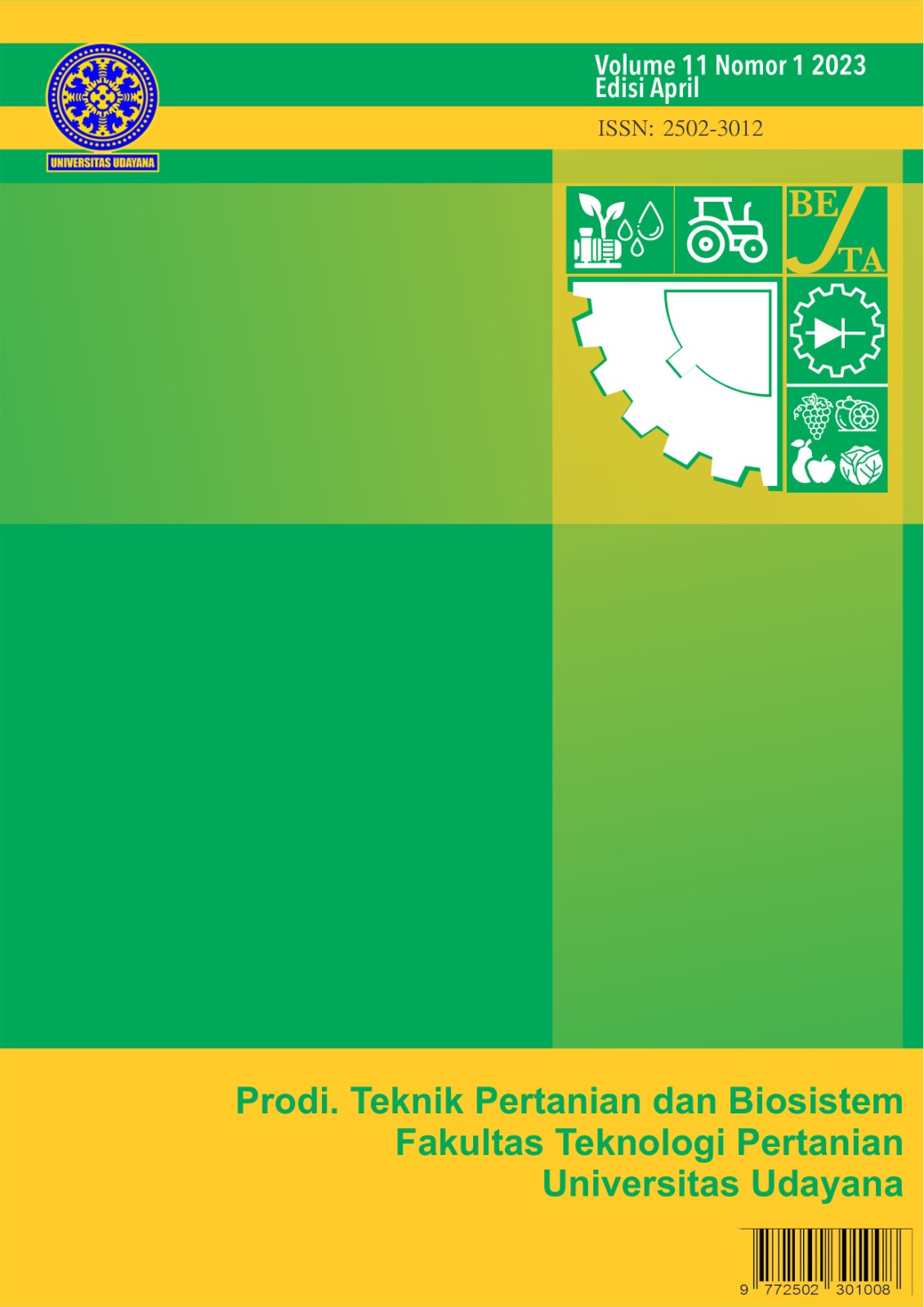Efisiensi Kinerja Traktor Singkal dan Traktor Rotari pada Pengolahan Tanah di Subak
Abstract
Abstrak
Sebelum petani Subak mengenal traktor, pengolahan tanah dilakukan dengan menggunakan cangkul atau bajak singkal yang ditarik oleh ternak. Pengolahan tanah dengan traktor yang dilengkapi dengan komplemen bajak singkal atau bajak rotari tidak dapat dihindari terjadinya kasus tumpang tindih (overlap) hasil pengolahan, sehingga hasil tanah olahan menjadi tidak efisien. Tumpang tindihnya hasil pengolahan tersebut terlihat dari perbedaan hasil tanah yang diolah. Berdasarkan kondisi tersebut diperlukan kajian efisiensi pengolahan tanah pada Subak dengan menggunakan traktor singkal dan traktor rotari pada pengolahan tanah tahap pertama. Efisiensi kerja traktor diukur berdasarkan perbandingan antara kerja teoritis dan kerja riil. Kerja teoritis diukur berdasarkan lebar komplemen alat olah baik bajak singkal maupun rotary serta rata-rata kecepatan gerak maju traktor saat mengolah tanah. Kerja riil diukur berdasarkan hasil kerja secara nyata di lapangan yaitu luasan lahan yang berhasil diolah dalam rentang waktu tertentu. Data kerja riil juga dikonfirmasi berdasarkan hasil diskusi dengan beberapa operator traktor. Dari hasil analisis data diperoleh efisiensi kerja traktor singkal sebesar 77,3% dan traktor rotari 55,2%.
Abstract
Before Subak farmers were familiar with tractors, land preparation was carried out using hoes or single-handed plows pulled by cattle. Land preparation with a tractor equipped with a complementary or rotary plow cannot be avoided in cases of overlap of processing results so that the processed soil results become inefficient. The overlapping results of the processing can be seen from the differences in the results of the processed soil. Based on these conditions, it is necessary to study the efficiency of tillage in Subak using single-axle tractors and rotary tractors in the first stage of tillage. Tractor work efficiency is measured based on a comparison between theoretical work and real work. Theoretical work is measured based on the width of the complement of the tiller, both short and rotary plows, and the average speed of the tractor's advance when cultivating the land. Real work is measured based on real work results in the field, namely the area of ??land that has been successfully processed within a certain time span. Real work data was also confirmed based on the results of discussions with several tractor operators. From the results of the data analysis, it was obtained that the work efficiency of the short tractor was 77.3% and that of the rotary tractor was 55.2%.
Downloads
References
Azzuhra, F., Devianti, D., & Yunus, Y. (2019). Analisis Beberapa Sifat Fisika - Mekanika dan Kinerja Traktor Roda Dua Akibat Pemberian Pupuk Organik dan Kedalaman Pengolahan Tanah Ordo Entisols. Jurnal Ilmiah Mahasiswa Pertanian, 4(1), 598–607. https://doi.org/10.17969/jimfp.v4i1.10409
Hernawan, E., Kartodiharjo, H., Darusman, D., & Soedomo, S. (2011). Insentif Ekonomi dalam Penggunaan Lahan (Land Use) Kawasan Lindung di Kawasan Bandung Utara (Incentive of Economy for Land Use in The North Bandung Area). Jurnal Manajemen Hutan Tropika, 15(2), 45–53.
Mardinata, Z., & Zulkifli. (2014). Analisis Kapasitas Kerja dan Kebutuhan Bahan Bakar Traktor Tangan Berdasarkan Variasi Pola Pengolahan Tanah, Kedalaman Pembajakan dan Kecepatan Kerja. AGRITECH, 34(3), 354–358.
Rizaldi, T. (2006). Mesin Peralatan. Fakultas Teknologi Pertanian Universitas Sumatera Utara.
Sulnawati, E. (2016). Analisis Teknis dan Kajian Ergonomika Berdasarkan Antropometri pada Penggunaan Traktor Tangan untuk Lahan Sawah. Jurnal Ilmiah Rekayasa Pertanian Dan Biosistem, 4(2).
Thoriq, A., Sugandi, W. K., Yusuf, A., & Nurhasanah, R. (2021). Analisis Kapasitas Kerja dan Kelayakan Usaha Agroindustri Beras. Jurnal Keteknikan Pertanian Tropis Dan Biosistem, 9(1), 43–55. https://doi.org/10.21776/ub.jkptb.2021.009.01.06
Widata, S. (2015). Uji Kapasitas Kerja dan Efisiensi Hand Traktor untuk Pengolahan Tanah Lahan Kering. Agro UPY, 4(2), 6470.












 Jurnal BETA (Biosistem dan Teknik Pertanian)
Jurnal BETA (Biosistem dan Teknik Pertanian)


